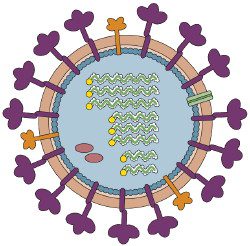

Examination of the sequence of all known influenza N1 NAs reveals that the proteins can be grouped into six classes depending on the length of the stalk region. The stalk regions of some NAs are intact, while others lack from 15 to 22 amino acids. In 2000, influenza H5N1 isolates from humans were identified with a deletion of stalk amino acids 49-68. The percent of human H5N1 isolates with this deletion has steadily increased from 15.8% in 2000 to 100% in 2007. This observation led to the question: does stalk length influence H5N1 pathogenesis in animals?
The authors produced a series of H5N1 reassortant viruses with NA stalks of different lengths. Six of the 8 viral RNAs were derived from the 1933 H1N1 isolate WSN. The pathogenicity of the reassortant viruses was determined in chickens and in mice. Three of the viruses were highly pathogenic in chickens: one with the NA from a 2004 H5N1 isolate containing the deletion of amino acids 49-68, a second with the NA from WSN virus, and a third with the N1 from a 1997 H5N1 isolate. The NA stalks from the latter two viruses have deletions, but they are different from the one in the 2004 H5N1 NA. The other viruses tested were found to be of low pathogenicity in chickens. These included a virus with an N1 from an 1996 H5N1 virus with an intact stalk, as well as viruses with NAs harboring different deletions of various lengths. The findings in mice paralleled those obtained in chickens.
These results show that the NA stalk plays a critical role in virulence of H5N1 avian influenza virus in chickens and in mice. The 20 amino acid deletion from amino acids 49-68 is associated with high virulence, although similar pathogenicity was observed for viruses with different stalk deletions. These results do not answer the important question: why viruses with this particular NA deletion have become prevalent among human H5N1 influenza virus isolates. H5N1 viruses with the same stalk deletion have been isolated from aquatic birds and terrestrial poultry since 2002. It has been suggested that the stalk deletion is associated with adaptation of influenza viruses to land-based poultry, but the advantages conferred by this particular NA are unknown.
Zhou, H., Yu, Z., Hu, Y., Tu, J., Zou, W., Peng, Y., Zhu, J., Li, Y., Zhang, A., Yu, Z., Ye, Z., Chen, H., & Jin, M. (2009). The Special Neuraminidase Stalk-Motif Responsible for Increased Virulence and Pathogenesis of H5N1 Influenza A Virus PLoS ONE, 4 (7) DOI: 10.1371/journal.pone.0006277

Are there any good theories as to why this is so? Perhaps the deletions better position the NA active sites for removal of sialic acid?
There must be a balance between HA activity (binding to sialic acid)
and NA activity (removing sialic acid). Each virus strain probably has
a different combination of HA and NA to reflect this. I think your
idea is on the right track. It's likely that the NA activity, balanced
here by deletion, comes about as a consequence of the activity of the
HA.
There must be a balance between HA activity (binding to sialic acid)
and NA activity (removing sialic acid). Each virus strain probably has
a different combination of HA and NA to reflect this. I think your
idea is on the right track. It's likely that the NA activity, balanced
here by deletion, comes about as a consequence of the activity of the
HA.
would you kindly tell me the difference between the N1 numbering system and the N2 numbering system ??